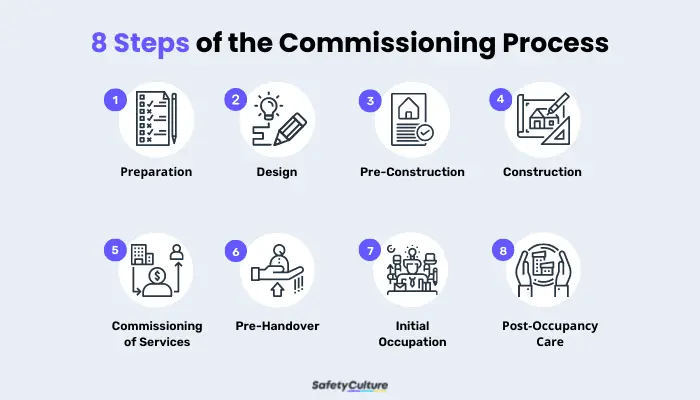What is Commissioning?
Commissioning is the methodical approach to ensuring that all operational components of a project—from planning and design up to the actual construction, implementation, or installation—are functioning as they ought to be. It aims to inspect, document, and verify that a project’s progress is at par with the project owner’s requirements and specifications. Additionally, commissioning provides the opportunity to proactively correct any oversights in the projects, thus, avoiding costly modifications at a later time.
Commissioning providers, project managers, and contractors implement commissioning to check not just the specific procedures or individual equipment but also the more complex sets of project segments, systems, and subsystems.
Why is it Important?
The major goal of the process of commissioning is to make sure that all project elements are operating per capacity, proper usage, and requirements, and that it helps meet the project owners’ expectations and needs.
In the context of Leadership in Energy and Environmental Design (LEED) for example, the process of commissioning is essential for a building to be LEED-certified. This procedure enables auditors to ensure that structures are built efficiently and with energy-saving capabilities at the forefront of the plans.
Additionally, commissioning is also a focus on specific systems within a facility such as the Heating, Ventilation, and Air Conditioning (HVAC), electrical structure, as well as the design of the building itself.
Improve your GRC management
Simplify risk management and compliance with our centralized platform, designed to integrate and automate processes for optimal governance.
Explore nowThe Four Main Types of Commissioning
From the installation of a project, building, or equipment to its continued maintenance and renovations over time, commissioning plays an important role in maintaining these assets’ lifecycle. To address the needs of a project according to its current status, here are the four main types of commissioning:
New Construction Commissioning
New construction commissioning or simply called commissioning, is the most common and widely-used type of commissioning. It is utilized for newly-built projects or those that are still in their design and construction phases. The project design, together with the project requirements and the commissioning plan, can be used as a guide on how the project components should operate and function. Commissioning at this stage also allows owners to identify defective systems and implement preventive measures as needed.
Re-Commissioning
Re-commissioning, as the name suggests, is the type of commissioning that helps maintain a project that has already been previously commissioned. It is typically used to inspect and validate that project components or building systems are still in good operating condition after a specific period of time and frequency of usage.
Retro-Commissioning
Retro-commissioning, meanwhile, happens to an existing project, equipment, or building that wasn’t commissioned during its design or construction phase. It aims to determine areas for improvement and recognize underlying problems before they even cause issues in operation. Additionally, retro-commissioning focuses on identifying energy-saving opportunities, efficient capabilities, and cost-effective functionalities.
Monitor-Based Commissioning
Monitor-based commissioning is a continuous and intuitive approach to maintaining a project. With the use of new technologies and innovative techniques, this type of commissioning enables commissioning providers to explore the systems in real-time and target specific components of a project. The main goal of monitor-based commissioning is to maximize energy use and identify retrofits needed for a building or equipment.
Commissioning Process: A Step-by-Step Guide
There are no definitive stages of commissioning that apply to all projects since they would still depend on the commissioning providers and the project itself. Below, however, are steps that are usually followed to implement a successful commissioning process:

Step 1: Preparation
In the planning stage, the commissioning team should first be formed and identified. The team could then study previously-handled projects that are similar to the current one to gain initial knowledge of items that should be noted. After that, the project owner’s requirements and expectations are defined and used as a guide in creating the initial details of the commissioning plan.
Step 2: Design
The design stage should help materialize a more specific, comprehensive, and detailed interpretation of the owner’s project requirements. The commissioning team should make sure that project conditions are clearly defined and concentrated on in the succeeding contracts and documents. If drawings and other design-related records are required for the project, they should also be included at this stage.
Create Your Own Commissioning Checklist
Eliminate manual tasks and streamline your operations.
Get started for FREEStep 3: Pre‐Construction
This stage focuses on the contractors’ understanding of the project expectations and deliverables. If needs for design modifications arise after initial reviews, they should be accommodated during this phase. The commissioning team is also provided the opportunity to verify that the trade contractors are indeed capable of meeting the project’s requirements. Basically, this stage acts as a buffer from the preparation phase before any of the commissioning plans are implemented in the next phases.
Step 4: Construction
Construction, as the name suggests, is the stage where the actual commissioning activities begin. The commissioning team should consistently observe the activities and ensure that system components are installed properly. Verification activities include quality checks, static tests, and system assessments. Through continuous monitoring, document performance results as proof that goals are achieved and design requirements are met.
Step 5: Commissioning of Services
Commissioning of services is a continuation of the previous stage. Consider this as another layer of verification activities, only this time, it’s more specific on the building itself, the equipment included, and the engineering services acquired. This stage involves observations from relevant people of the facility or project owners.
Step 6: Pre‐Handover
This stage serves as an introduction to the project’s final phase. Consolidate all the documentation needed while confirming that all recorded evidence is of quality and would strengthen the integrity of the commissioning process. This stage also includes training for facility personnel and training for equipment users and operators. In addition, a user guide that details specific instructions about the building or equipment is distributed.
Step 7: Initial Occupancy
At this stage, construction and installation are complete. Users and owners are introduced to the outcome of the project and shown how the project components operate. If there are modifications needed after the initial occupancy, they should be consulted with the commissioning team and the project owners, then documented in the commissioning records.
Step 8: Post-Occupancy Care
The last stage, post-occupancy care, enables the commissioning providers to conduct periodic checks on the project to see and verify its performance. Again, if there are modifications identified to refine the components, they should be noted and implemented here. Finally, compare the most recent outcome against the intent, objectives, and requirements of the project.




